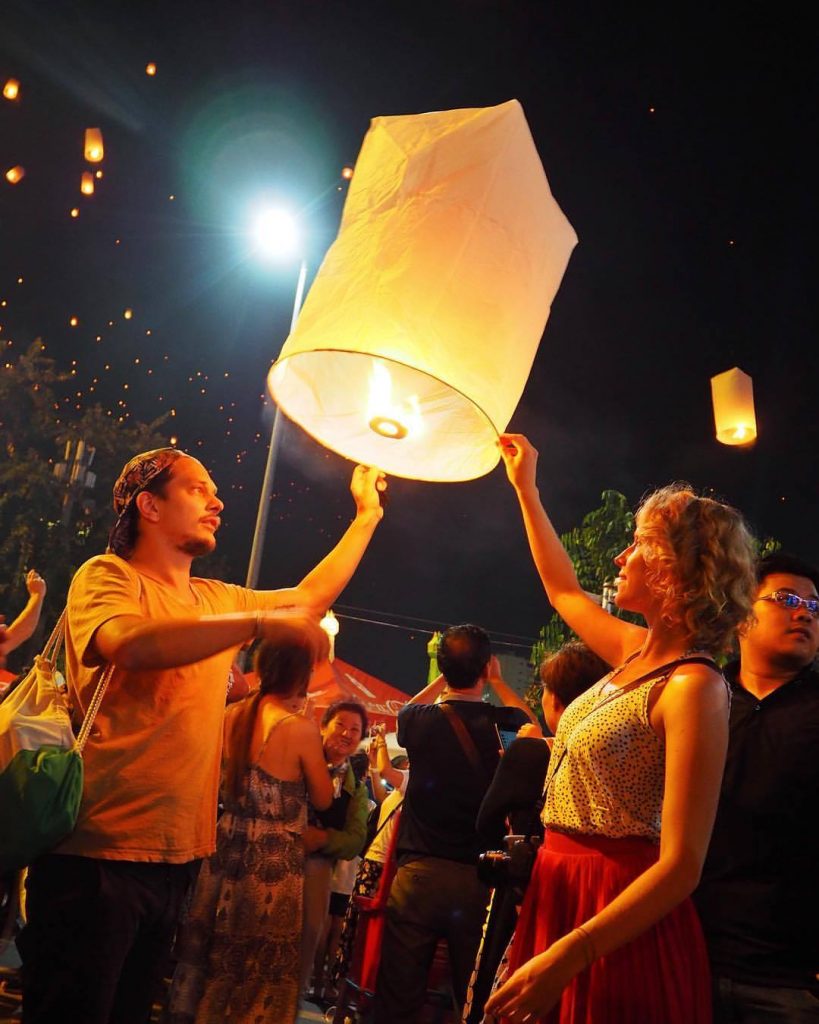A year ago yesterday, I was in Chiang Mai, Thailand and stoked to attend my first-ever Asian lantern festival.
Throughout Asia, from Thailand to Hong Kong to India, lantern festivals are common – heavily attended and widely loved.
When you see photos, it looks like magic. Thousands of sparks carrying high into the sky, like wishes aloft. From afar, it’s an ethereal, otherworldly experience.
At the time, I didn’t say much, but the truth is, I doubt I’ll ever attend another lantern festival. I can’t dispute the sheer beauty – they make for incredible images. It’s every bit as magical-looking as you’d think, when sipping a beer on a patio in the distance, glancing heavenward.
But these are festivals that have deep roots, going back as much as 2,200 years in Han China! What a completely different world that was. I can’t even imagine how amazing it must have been for those people of so long ago.
Today, there are 7.6 billion people on the planet, and 60% of the world lives in Asia. You have never experienced crowds and bustle until you’ve been to Asia. And lantern festivals don’t just bring out the locals, they’re a hot time for tourists. People travel halfway around the world just to experience these events.
I get it, man. It’s magical. I understand.
What it looks like, though, and how it unfolds are two very different things.
The streets are crammed with people. Like, you have never been jostled such as you will be when negotiating the madding throngs en route to the lantern festival. Everyone wants to set the lanterns off near the rivers, which can be beautiful as the flames reflect into the water below, and it means a few select streets have you crammed in like beans in a bag.
But a hundred years ago, these places didn’t have power lines. A hundred years ago, there was about 20% of the population, if not less. A hundred years ago, lanterns weren’t mass-produced and sold dirt-cheap.
And therein lies the start of my problems with the event.
I went to the bridge and was in awe of how gorgeous it all looked. But then the guy next to me had a flaming lantern fall onto his back. The problem was the power line just off the bridge, and lanterns were catching on the powerlines all around us, then going up in flames and the burning constructions were falling back on attendees below.
By this point, I’d already noticed seen many lanterns were getting stuck in trees, with some tree canopies catching fire. There was something weirdly beautiful about that which transfixed me for a time, probably going deep into my psyche as a kid raised in the Catholic Church amidst stories of Moses and the burning bush and the voice of God.
But then it became about the high frequency at which lanterns fell back down and burned people. Some began to panic and left in a haste.
And then there was the waste.
Back in the day, meaning for literally nearly two thousand years, people made their own lanterns, so they’d have a few but that was it. Now they could buy them for cheap and the business was booming – every 15 feet, someone else was trying to undercut their neighbour as they sold all manner of lanterns for a few Thai bahts each. These were made of cheap paper affixed to wire frames with a fuel cell.
Historically, they were made of bamboo frames and usually thin rice paper. Some people still make their lanterns at home, and there are floating lanterns with banana leaves to sail down the river that are popular, but most airborne lanterns today are made of metal.
Now, these metal lanterns cause widespread garbage. They burn longer, travel further. They catch in trees, with a longer burn time increasing the threat of fire. They fall all over the place.
And sure, you can clean them up. Sure, you can recycle them. But they’re still a natural resource being mined and manufactured, shipped in a plastic wrap. To light them, we use plastic disposable lighters filled with gas from a limited resource, and on it goes.
By the time I got home that night, I found myself frustrated and sad. There are things which are beautiful and historic, and I love that they have existed, but with the world as populated as it is, resources as threatened as they are, and manufacturing practices as wasteful as they are, some events are better left in history.
It was unsurprising the next day when nomad and expat groups on Facebook spread stories about houses that had burned down, hospitals packed with burn injuries, and litter everywhere from the celebrations – including disposable food packaging and such – and the lanterns. And the festival would continue for days more.
Superstition tells you that lighting and sending these lanterns up will take your bad luck away with them. Tell that to the guys whose homes burned down.
I understand why people want to experience these historic nights. I did, for sure. I’ve never heard people talking about the waste and destruction, and it’s like we gloss over these realities just because it’s so pretty and, well, HEY, it’s pretty!
But now that I have been to a lantern festival, I understand why we as a society need to accept that they are completely unsustainable and profoundly damaging to our ecology and even some people’s livelihoods.
And this, kids, is how our nomad came to love and loathe the lantern festival.
I hope that, within my lifetime, these become a thing of the past. I’ll be eternally grateful I saw one, because then it will be easy for me to not lament the end of them.
Man, I’m such a buzzkill. But that’s travel for ya – an endless stream of experience-broadened perspectives.

People light a lantern to set aloft in Chiang Mai, Thailand.


